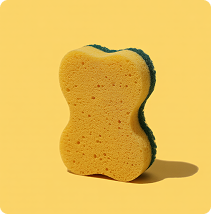How to Replace
Cleaning Sponges
Discover reusable alternatives that clean better and never leave you scrambling to the store.

The Problem With Cleaning Sponges
🦠Your "Clean" Sponge is Crawling with Germs
- 32 million bacteria per sponge: Studies found the average kitchen sponge contains nearly 32 million bacteria—making it potentially one of the dirtiest items in your entire house.
- 362 different types of harmful bacteria: Research discovered 362 different bacterial species lurking in sponges—including ones associated with foodborne illness that could affect your family’s health.
- 75% contain E. coli-type bacteria: A National Science Foundation study found 75% of household sponges had coliform bacteria—the same type found in human waste and linked to food poisoning.
🔄You're Actually Making Things Dirtier
- Spreading bacteria instead of cleaning: When you use a contaminated sponge, research shows you’re spreading bacteria all over surfaces rather than cleaning them—potentially making your kitchen more dangerous than before.
- Cross-contamination between surfaces: Using the same sponge on multiple areas can transfer harmful bacteria from one surface to another—exactly what you’re trying to prevent when cleaning.
- Even “cleaning” your sponge makes it worse: German researchers found that trying to clean sponges with soap and water actually selects for more resistant, potentially harmful bacteria—making the problem worse, not better.
💸Weekly Replacement Costs Add Up Fast
- Experts recommend replacing weekly: Microbiologists suggest replacing sponges every single week to prevent dangerous bacterial buildup—meaning 52 sponges per year, per household.
- $30+ annually just for basic sponges: With weekly replacements at around 60 cents each, families spend over $30 yearly on disposable sponges—money that could go toward better alternatives.
- Most people wait way too long: While experts say weekly, many families keep sponges for weeks or even months—unknowingly exposing their families to escalating bacterial loads during that time.
🌊Invisible Plastic Pollution in Your Water
- 6.5 million microplastic particles shed per gram: Every time you scrub with melamine sponges, they release 6.5 million microplastic fibers per gram of wear—particles so small they pass through water treatment plants.
- 1.55 trillion fibers released globally each month: Researchers calculated that sponge use worldwide releases over 1.55 trillion microplastic fibers monthly—contributing to water contamination that affects entire food chains.
- Made from petroleum-based plastics: Most kitchen sponges are manufactured from petroleum-based polyurethane and other plastics—meaning every dish-washing session potentially adds microscopic plastic to your water supply.
This content is for informational purposes only and is not professional advice. Always do your own research before making decisions. No guarantees are made regarding accuracy or outcomes.
Top Picks